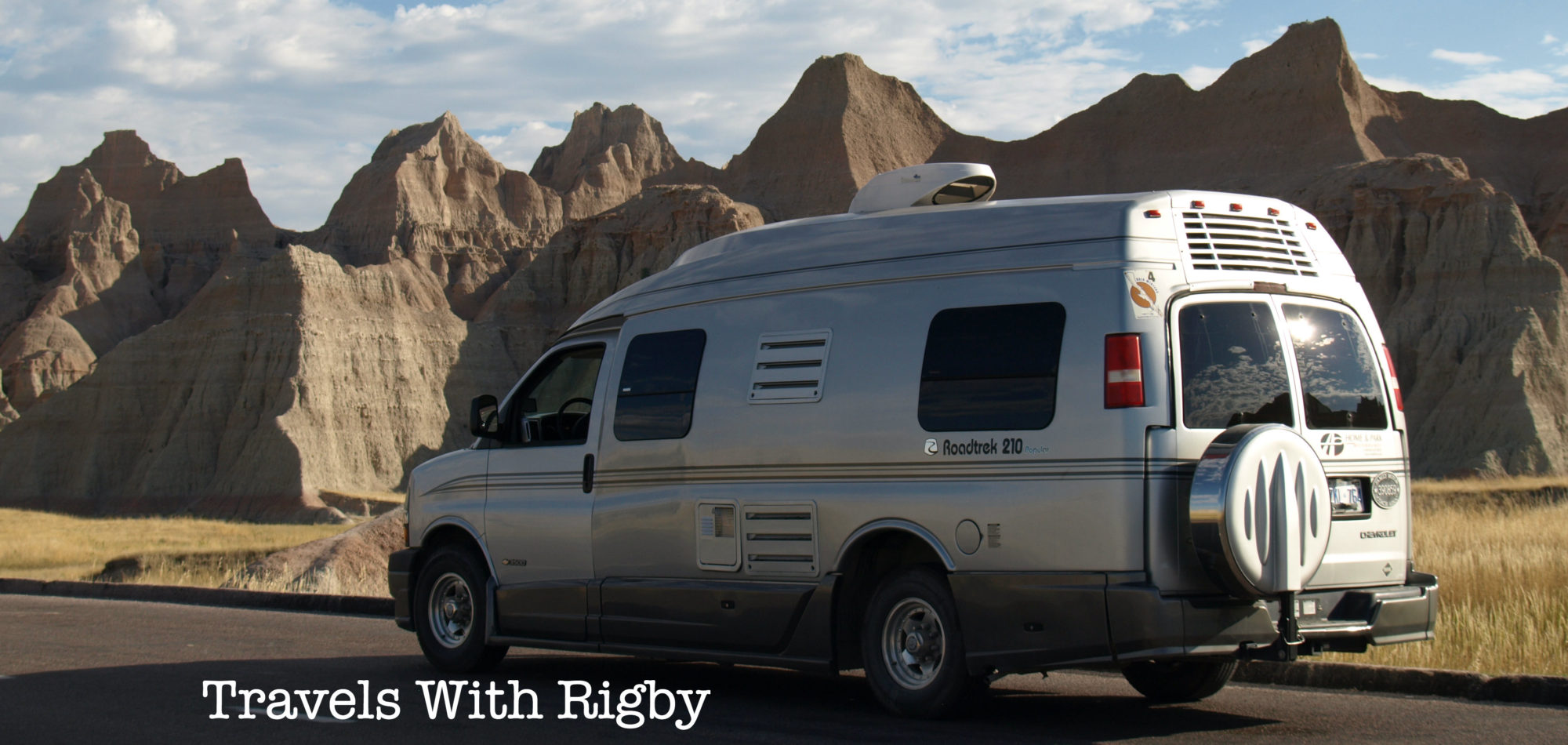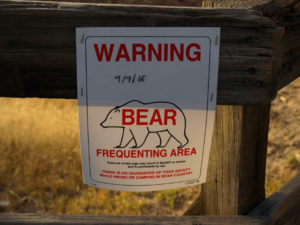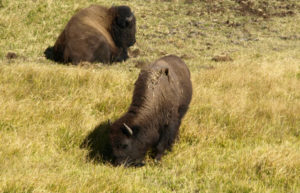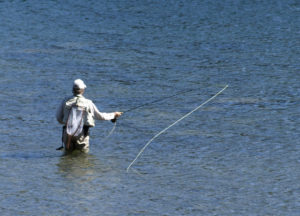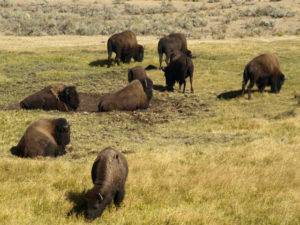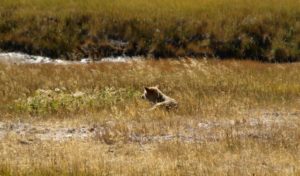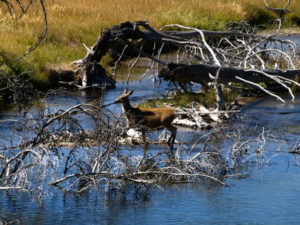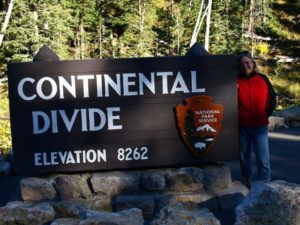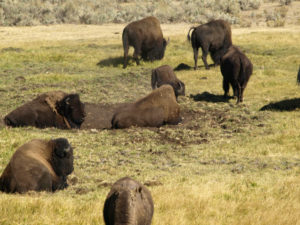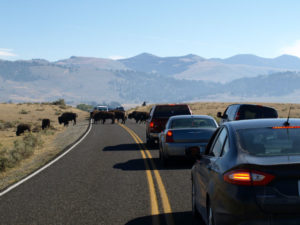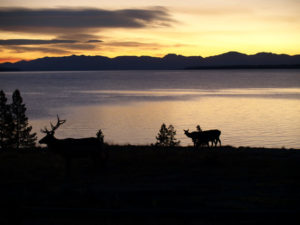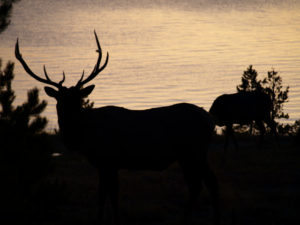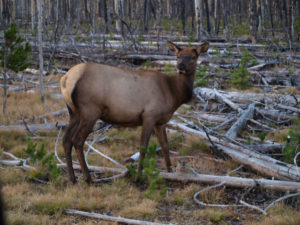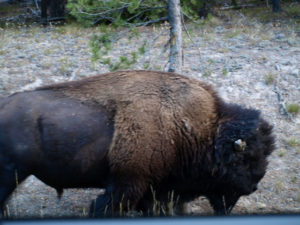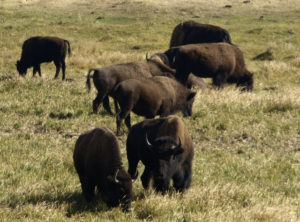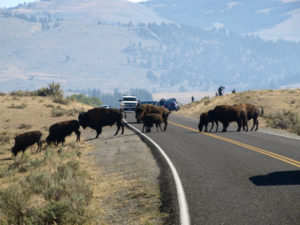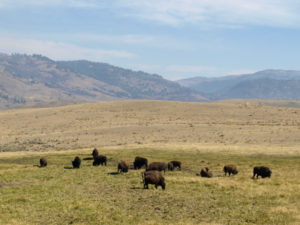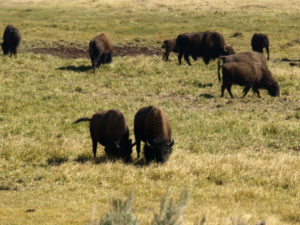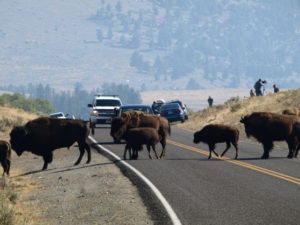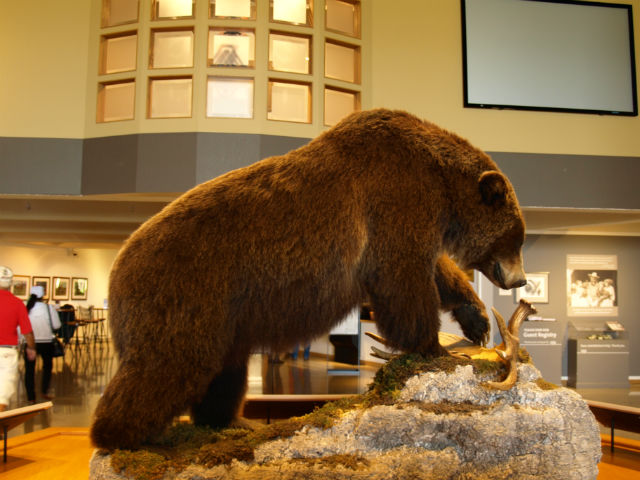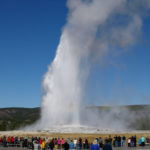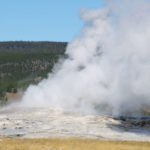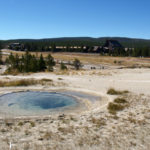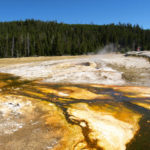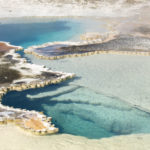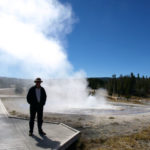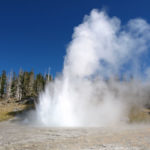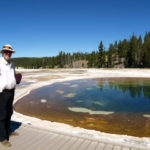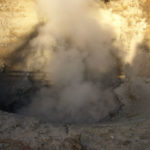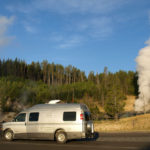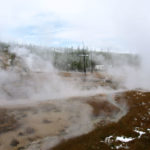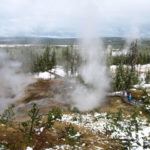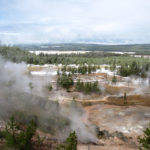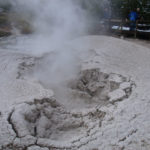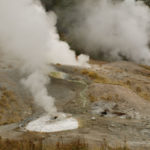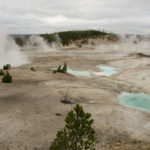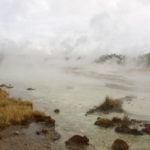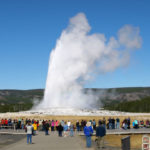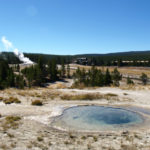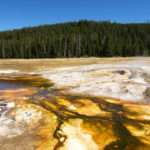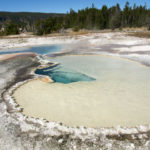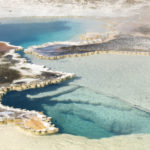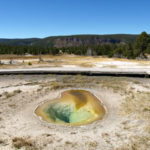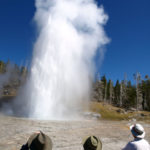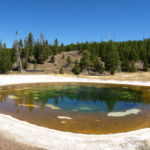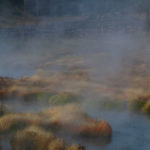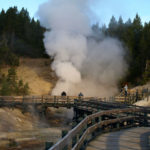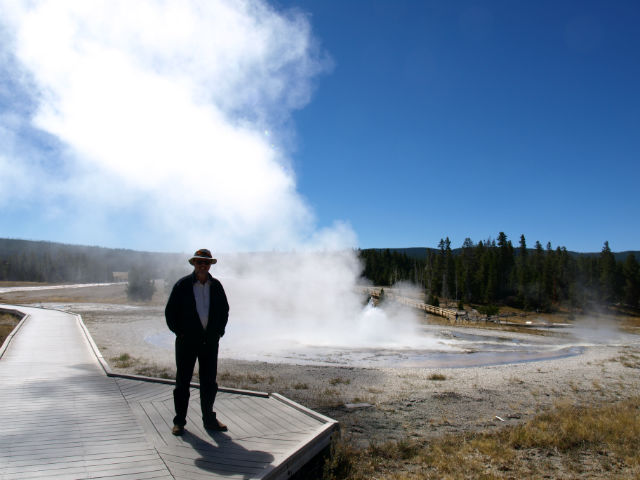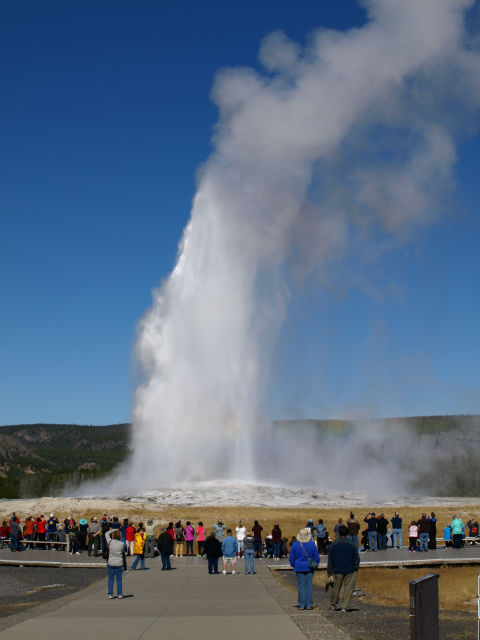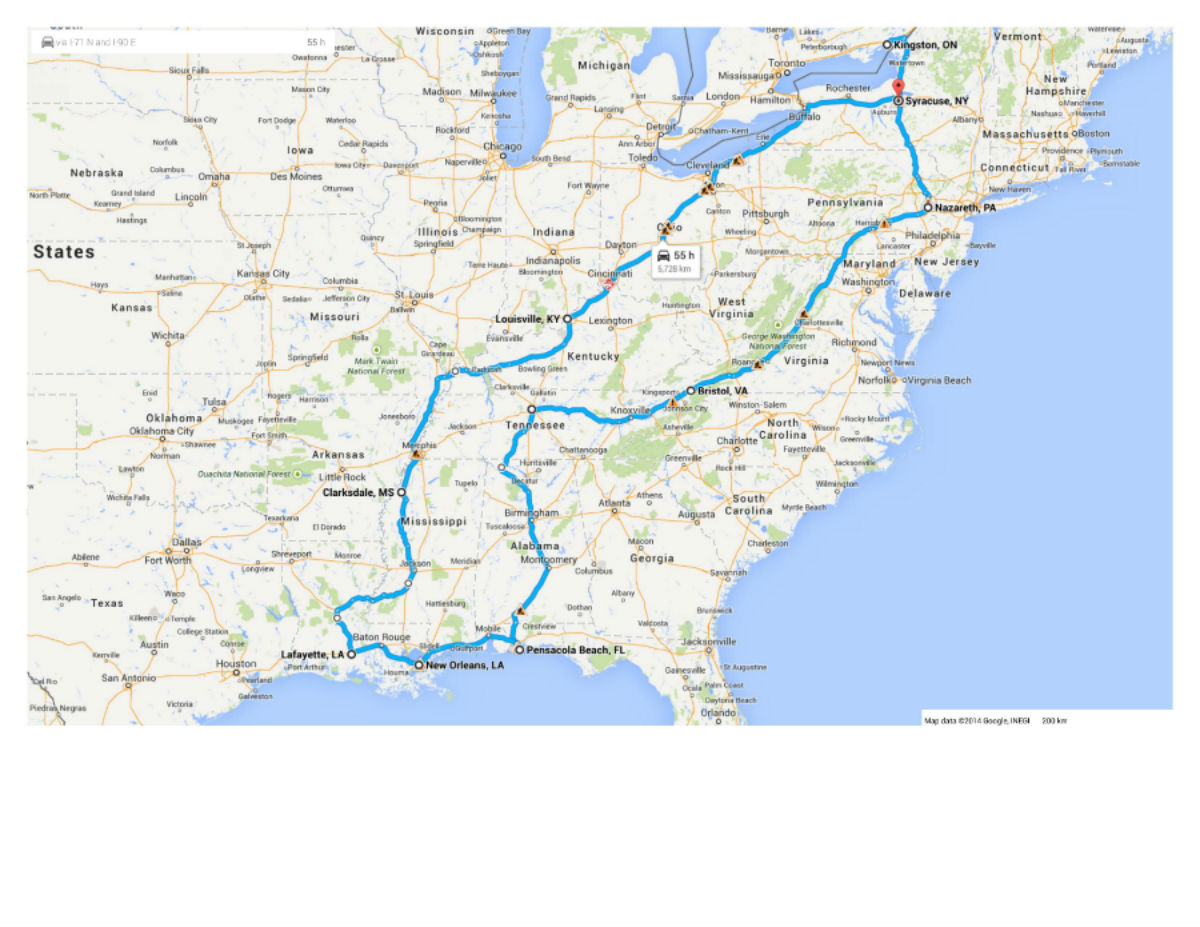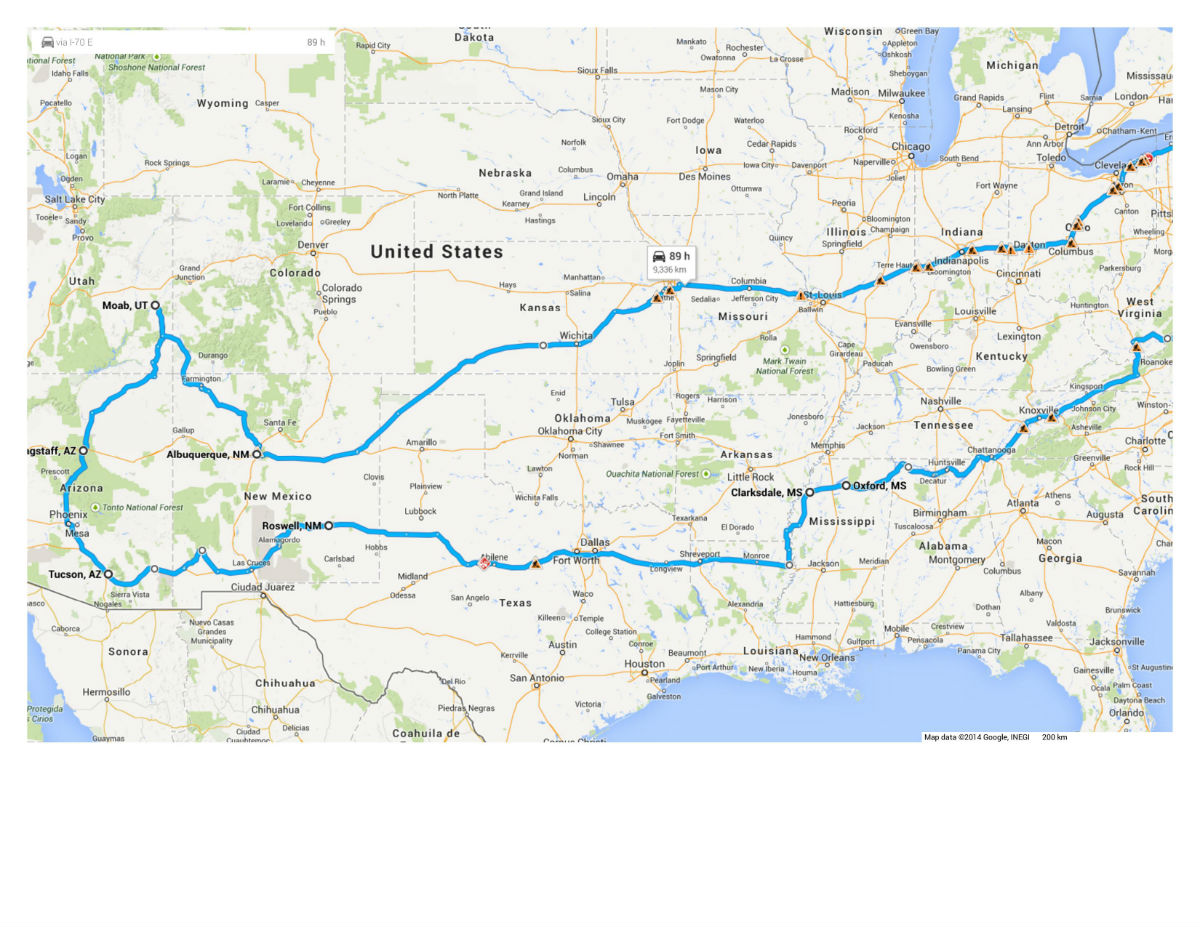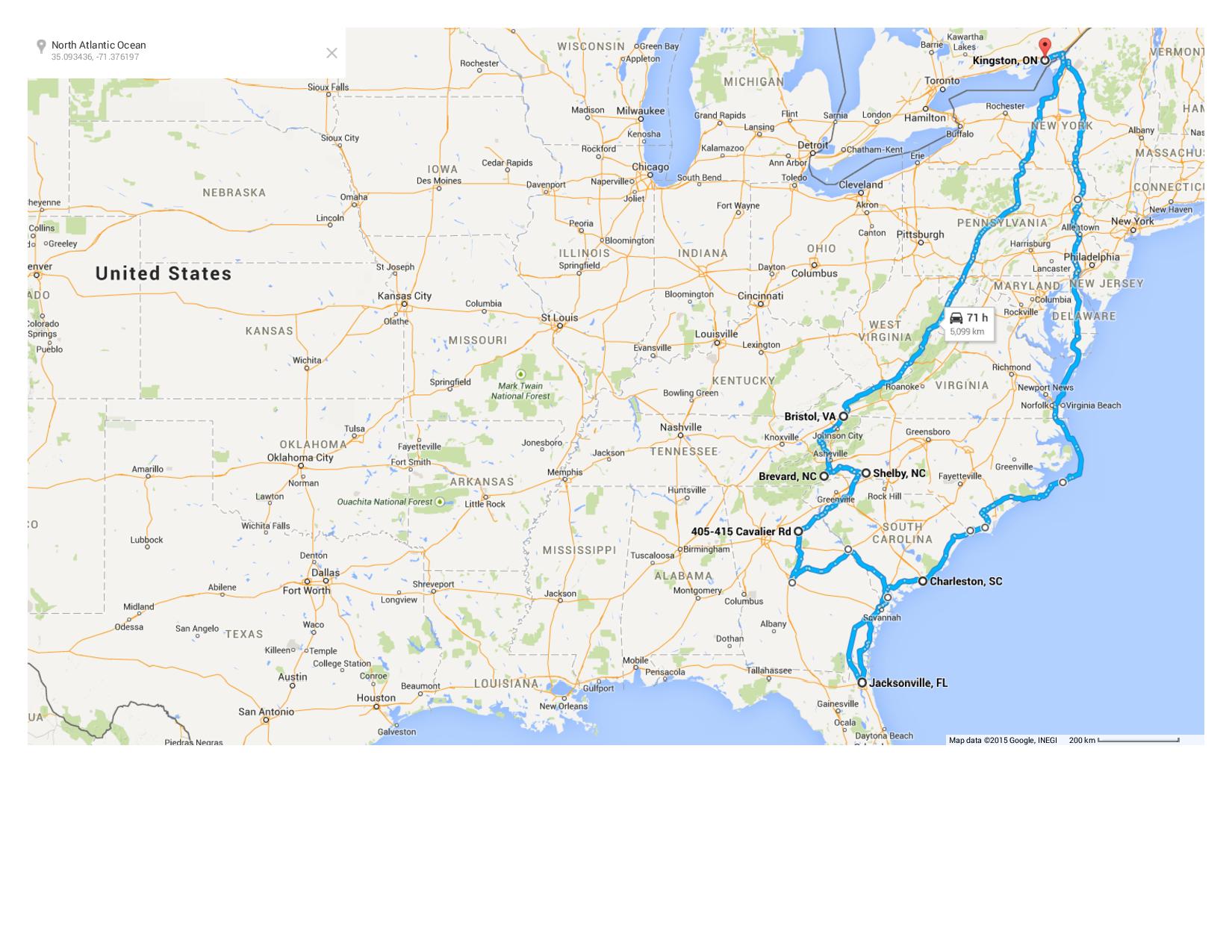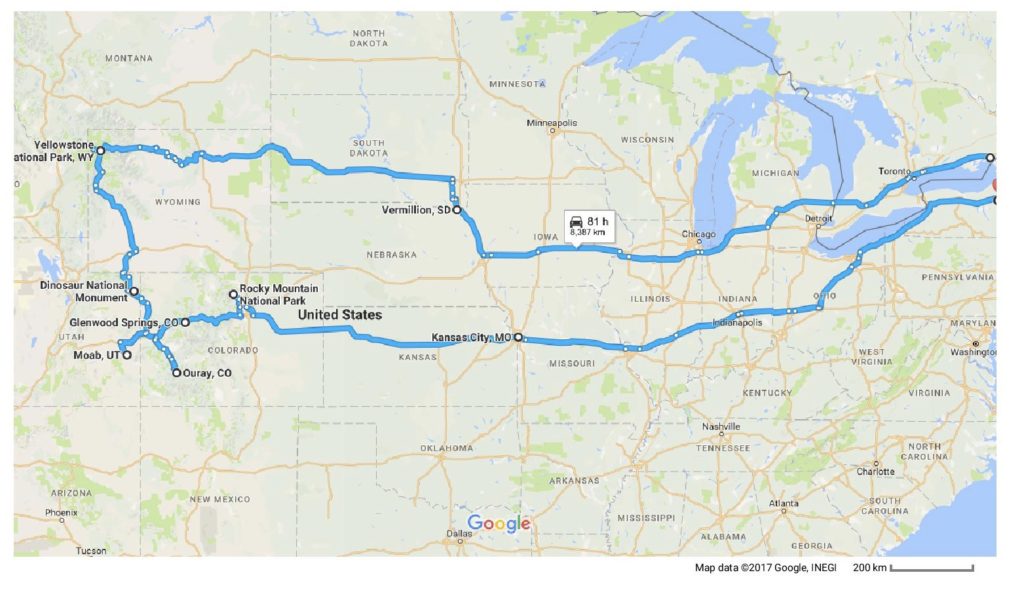Just 90 seconds of video … a little bit of Yellowstone’s amazing geothermal activity. This is what it’s like to be in the middle of the caldera in a super volcano! YELLOWSTONE SHOWS ITS STUFF!
Tag Archives: Yellowstone National Park
Yellowstone wildlife photos . . .
(Almost) blasé about bison
We got our first idea of the Yellowstone wildlife to expect back in Cody, WY at the amazing Buffalo Bill Center of the West. In the Draper National History section there were detailed explanations of the various landscapes that make up the Greater Yellowstone region – the more open Northern Range, the lodgepole pine forests (they cover 80% of the parkland), the plains (“where the buffalo roam”) and the mountain meadows. It was just the primer we needed before heading into the park.
Signing into the Yellowstone campgrounds involves more than just site assignment. We had to initial a waiver acknowledging that we were in grizzly country. Huge metal food lockers for tenters to use. Lots of bear information – the what-to-do-if scenarios. Dogs are not allowed on the hiking trails (sorry Rigby) although it’s pretty easy to understand.
Now that we’re here, we’ve seen lots of wildlife (although not the elusive gray wolf nor the grizzly). So many bison that after a day or two you start to get blasé about the experience. Ditto for the elk – although we did have a magical early morning viewing of elk silhouetted against the sunrise that will be forever imprinted on our brains. There have been many deer and a coyote snoozing in the field between the geysers. One, lonely bighorn sheep (“the master of the mountain”) nibbling on some grass and a flock of snow white pelicans fishing in the Yellowstone River. At the museum we learned that the bighorn sheep have air filled chambers in their skulls to absorb head-on-blows.
On the second day in Yellowstone, we set our alarm for 6am and were on the road 15 minutes later – freshly-brewed coffee in hand – for a day devoted to wildlife watching (gotta love the Roadtrek – it really is up-and-out in no time). Luckily, the day we chose was the one day we’ve had here with clear blue skies from start to finish.
We were barely out of the campground when we came across the harem of elk, with the sun just barely coming up behind the Absaroka Mountain Range to the east. We stopped and just watched for a good 10 minutes. What a way to start the morning!
Our goal for the day were the wildlife rich Hayden and Lamar Valleys – more open grasslands favoured by the larger animals, like the bison. And we wanted to get there early, before the car traffic started to clog the roadways.
It wasn’t long before we were slowed to a crawl by our first bison jam. These iconic symbols of the West can weight 2,000 lbs and charge at 30 mph (you and me can run – maybe – 10 mph, so you do the math). If they decide to cross the road, there’s no argument.
In the early 1800s there were an estimated 60 million bison roaming the Great Plains of the West. They were hunted so intensely that they were almost wiped out – by 1890 there were fewer than a thousand left. The Yellowstone herd was protected in the early 1900s and has now grown to a herd of about 4,000.
The Lamar Valley and the Northern Range are much more open, fewer trees, more grasslands and high plateaus peppered with sagebrush. This open topography is favoured by the bison and by the grizzlies. Saw the former (in spades), still looking for the latter. Black bears prefer the mix of woods and meadows.
When you come to Yellowstone and are looking for wildlife, here’s where you want to go:
- Lamar Valley and Hayden Valley – elk and bison
- Yellowstone River – fly fishing (catch and release only) and white pelican flocks
- Northern Range – gray wolves and bear (black and grizzly), bison, elk, deer and pronghorn antelope
We’ve posted a separate photos-only piece about Yellowstone wildlife. Have a look. Have you been to Yellowstone? If so, what wildlife did you come across?
Yellowstone: Photo show
Yellowstone National Park is a place that touches all the senses: sight, smell and the sound of those geysers blasting and burping into the air. How about some photos to tell the story (click on any one to enlarge) . . .
Yellowstone: An Acts of God theme park!
Think of Yellowstone as an “Acts of God Theme Park.” It’s the most apt description we could conjure. There is so much to see and do in this mammoth national park that we’ve decided to write several posts – one on the geothermal activity in the park and another on the incredible wildlife. In addition, we’re going to create a few “photos-only posts.”
A bit of background: Yellowstone is the first U.S. National Park, established in 1872 by President Ulysses S. Grant. Pull out your map – you’ll find it in the northwest corner of Wyoming (although margins of the park cross over into Montana and Idaho).
Of course, as soon as we arrived at our campground, the temperature plummeted and it snowed. We felt so sorry for the campers in tents but we stayed dry and warm. We stayed at both Grant and Madison campgrounds operated by Xanterra – if you visit, make reservations early as the campgrounds fill up (even in snowy and cold weather!). The sites were well wooded and – this was a first for us – on registration we had to sign an acknowledgement about bear activity, both black and grizzly. There are large metal food storage boxes for tenters to use and all sorts of signs about bear activity.
So, let’s start with the geothermal sights. Everyone knows about Old Faithful – it’s one of 10,000 geothermal volcanic vents in the park – it was great but not the most interesting by far. A park staff member told us it gets the most press because “you don’t have to walk far from the parking lot to get to it.”
We couldn’t get enough of the other sites – we laced up our hikers and walked the boardwalks, paths and overlooks to see steaming hot springs, mud pots belching blobs of liquid clay, geysers that erupted columns of superheated water, green, yellow and blue hot pools. And everywhere, streams of steam rising into the air.
The park is actually the location of a huge collapsed volcano caldera, the remains of the last major eruption 640,000 years ago. The huge crater marks the volcanic heart of the park. Oh yeah . . . It’s due to blow anytime and the eruption would wipe out most of the Northern hemisphere – isn’t that a cheery thought?
A few facts to wrap your mind around:
- Yellowstone contains more hydrothermal wonders than anyplace on Earth (10,000+).
- Half the world’s geysers are located here.
- Hot springs seep to the surface and form steaming and bubbling hot pools.
- Yellowstone is connected to the centre of the Earth – the source of heat for these geothermal features is molten rock.
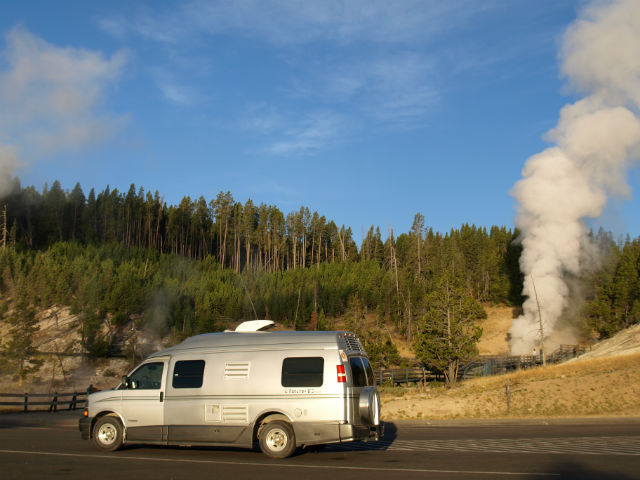
Here’s our list of the best of the best – geothermal features that really captured our attention:
- Grand Geyser – about a 30-minute walk along the boardwalk trail from Old Faithful and worth every step. It blows about every 90 minutes (a guesstimate) and shoots seven storeys into the air. Bonus: it lasts quite a while, five minutes plus.
- Castle Geyser and Beehive Geyser – also on the Old Faithful boardwalk trail.
- Mud Volcano and the Dragon’s Mouth – luckily we arrived early (7am) and well before the tour bus crowds, so had most of the place to ourselves. Imagine what a dragon would look like with its mouth open, constantly belching steam and fumes from the bowels of the earth and you’ve got a pretty clear picture.
- Artists Paintpots with its fascinating grey clay mudpots. Imagine mud in the top of a double boiler and you’ve got the idea.
- Norris Geyser Basin and the Porcelain Basin boardwalk is filled with geysers, mudpots, thermopools, the latter is the home to extremophile and thermophile organisms that thrive on the high temperatures and acidity.
- It is impossible to find words that do justice to how expansive and otherworldly all this geothermal activity is. So, we’ve added an additional “photos-only” post. If you’ve been to Yellowstone, we’d love to hear your impressions. Please share your link to our posts and let us know about your own adventures to this part of the planet.
www.YellowstoneNationalParkLodges.com provides info and online reservations for lodging and campgrounds in Yellowstone
Words on the page
Our stories and articles appear in Canadian magazines and online.
Spring and fall, we load the van – with everything from guitars to laptops – toss in a thick bundle of maps, several notebooks and roll down the road. We meet great people, gather wonderful story material and then write, write, write. Browse the links to some of our pieces in print:
BIG TRIP #1: ROOTS OF AMERICAN MUSIC: 9,000 km through the Southeast U.S.
- Road Tunes: A Six-Week Odyssey Following the Scenic Music Trails of the Southeast U.S., CAA Magazine. Road Tunes
- A Moment in Time, CAA website. A Moment in Time
- Great Music Trails of the American Southeast: The Journey Begins, Zoomer
- Travelling the Crooked Road Music Trail, Zoomer
- Walking, Strumming and Singing in the Footsteps of History, Zoomer
- New Orleans: Sensory Overload, Zoomer
- Great Music Trails: Bayou Cajun Country, Zoomer
- Great Music Trails: Louisiana’s Prairie, Zoomer
- Feeling the Blues in the Mississippi Delta, Zoomer
- Tennessee: Two Cities, Two Histories, Zoomer
- Kentucky: Where North and South Overlap, Zoomer
- Virginia’s Crooked Road is a journey through America’s musical roots, Canadian Traveller. Crooked Road
- Sunshine Bound, CAA website
- The Soundtrack to America, Canadian Traveller
- Soul Survivors, Doctor’s Review
- Music Cities, Dreamscapes
BIG TRIP #2: TUNES, RUINS & STARS: 13,000 km across the American Southwest
- A Canadian’s Guide to Arizona, Canadian Traveller.
- Flavours of the Southwest, Taste. Flavours of the Southwest
- A Grand Finale | Flagstaff, Arizona, CAA website. A Grand Finale | Flagstaff Arizona
- Where Ancient Cultures Thrive, Doctor’s Review
- The King Lives On, CAA website
- The Mississippi Delta: Drawn by the Blues, Zoomer
- Elvis Was Here.PDF, Zoomer
- Discovering Southern New Mexico, Zoomer
- Off the Beaten Path: Southeast Arizona, Zoomer
- True West: True Tucson, Zoomer
- Eight Things You Didn’t Know About Phoenix, Zoomer
- Often Overlooked – Arizona’s Four Corners, Zoomer
- All About Albuquerque, Zoomer
- The Mystery of Chaco Canyon, Zoomer
- Colorado Cliff Dwellings of Mesa Verde, Zoomer
- Exploring America’s Southwest, West of the City
- Food, Glorious US Food, Canadian Traveller
- Arizona – A Warm Welcome, A Canadian’s Guide to Arizona
- Arizona – Hot in the City, A Canadian’s Guide to Arizona
- Arizona – Pick Your Own Desert, A Canadian’s Guide to Arizona
- Arizona – Living in the Lap of Luxury, A Canadian’s Guide to Arizona
- Centennial views, Doctor’s Review
BIG TRIP #3: HUGGING THE ATLANTIC COASTLINE; MUSIC INLAND: 7,064 km
- North Carolina’s Outer Banks, Zoomer
- Sunshine Bound, CAA website
- Outer Banks: Sky, Sea & Sand, Zoomer
- Pirates of the Carolinas, Doctor’s Review
- South Carolina’s Coastline Cities, Zoomer
- Beaufort and the Beautiful Sea Islands, Zoomer
- Strolling in Savannah, Zoomer
- The Soundtrack to America, Canadian Traveller
- Cumberland Island National Seashore, Zoomer
- Soul Survivors, Doctor’s Review
- Georgia on my mind: Athens, Macon & Augusta, Zoomer
- North Carolina’s Appalachia: Steeped in Music, Zoomer
- Our last loop: Virginia’s Crooked Road, Zoomer
- Eat Your Way to Florida, CAA
- North Carolina’s Outer Banks, Canadian RVing
BIG TRIP #4: ROCK & ROLL: 10,950 km exploring western U.S. National Parks
- South Dakota’s Badlands Aren’t Bad At All, Zoomer
- The Enduring Legacy of Black Hills National Forest, Zoomer
- The Western Flair of Northern Wyoming, Zoomer
- The Hillsides and Grasslands of Yellowstone National Park, Zoomer
- Yellowstone & Grand Teton: Visiting Two Beautiful National Parks, Zoomer
- 3 Reasons Why Utah is a Road Tripper’s Dream, Zoomer
- The Scenic Soaks and Wildlife of Colorado, Zoomer
- A World of Rocks at Black Canyon of the Gunnison National Park, Zoomer
- A Holiday Trip to Seneca Falls, NY, CAA
- Colorado – Dreamscapes 2017, Dreamscapes
- Finding America’s Musical Roots in the Midwest, Zoomer
MISCELLANEOUS
- Dairy queens, Doctor’s Review
- Vermont Cheese Trail, Taste
- Rediscover Freedom In an RV, 2015 Travel Guide to Canada
- Cozy Up To Canada’s Natural Side, 2015 Travel Guide to Canada
- Rediscover Freedom in an RV, Dreamscapes
- Road Tripping the Blues Across Mississippi, Canadian RVing
- The Natural Beauty of the Thousand Islands, Canadian RVing
- Campsites We Love, Southbound
-
Exploring The Small-Town Charms of New Brunswick’s Bay of Fundy, Zoomer
- One Perfect Week in PEI, Canadian RVing
- U.S. Civil Rights Trail , Canadian RVing
- Prince Edward Island: A Community Built Around Food, Zoomer
- Nibbling Along the Vermont Cheese Trail, Canadian RVing
- Florida wild landscapes, Canadian RVing
